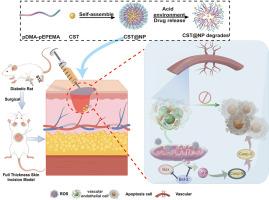Acid-responsive CST@NPs enhanced diabetic wound healing through rescuing mitochondrial dysfunction
IF 18
1区 医学
Q1 ENGINEERING, BIOMEDICAL
引用次数: 0
Abstract
Diabetic ulcers (DUs) are persistent and challenging complications of diabetes. The consequences of DUs include a decline in functional status, increased risk of infection, hospitalization, and even death. Our study revealed a significant decrease in the levels of cortistatin (CST) in the skin tissue of patients with DUs and diabetic rats. This finding led us to hypothesize that the administration of exogenous CST is an effective strategy to promote wound healing in patients with DUs. We herein successfully prepared CST-loaded pDMA-pEPEMA nanoparticles (CST@NPs) designed to exhibit localized, acid-responsive behavior for enhanced wound healing. These CST@NPs were sensitive to acidic environments, triggering the rapid release of CST. In vitro experiments showed that CST@NPs effectively alleviated oxidative stress and reduced apoptosis in human umbilical vein endothelial cells (HUVECs). Our findings further demonstrated that CST@NPs accelerated re-epithelialization of the wound, enhanced collagen deposition, and stimulated angiogenesis, while alleviating the local inflammatory response. Both in vivo and in vitro results indicate that CST@NPs possess precise and rapid response capabilities in acidic environments, ensuring effective CST release to promote diabetic wound healing. In summary, this acid-responsive nanoparticle system presents a highly efficient therapeutic strategy for the treatment of chronic diabetic wounds.

酸响应CST@NPs通过挽救线粒体功能障碍促进糖尿病伤口愈合
糖尿病溃疡(DUs)是糖尿病的顽固性并发症,具有挑战性。溃疡的后果包括功能状态下降、感染风险增加、住院甚至死亡。我们的研究发现,糖尿病溃疡患者和糖尿病大鼠皮肤组织中的皮质素(CST)水平明显下降。这一发现使我们推测,给予外源性 CST 是促进 DUs 患者伤口愈合的有效策略。在此,我们成功制备了负载 CST 的 pDMA-pEPEMA 纳米颗粒(CST@NPs),其设计表现出局部酸反应行为,可促进伤口愈合。这些 CST@NPs 对酸性环境很敏感,能引发 CST 的快速释放。体外实验表明,CST@NPs 能有效缓解氧化应激,减少人脐静脉内皮细胞(HUVECs)的凋亡。我们的研究结果进一步表明,CST@NPs 加快了伤口的再上皮化,增强了胶原沉积,刺激了血管生成,同时减轻了局部炎症反应。体内和体外实验结果均表明,CST@NPs 在酸性环境中具有精确、快速的反应能力,可确保有效释放 CST,促进糖尿病伤口愈合。总之,这种酸响应纳米粒子系统为治疗慢性糖尿病伤口提供了一种高效的治疗策略。
本文章由计算机程序翻译,如有差异,请以英文原文为准。
求助全文
约1分钟内获得全文
求助全文
来源期刊

Bioactive Materials
Biochemistry, Genetics and Molecular Biology-Biotechnology
CiteScore
28.00
自引率
6.30%
发文量
436
审稿时长
20 days
期刊介绍:
Bioactive Materials is a peer-reviewed research publication that focuses on advancements in bioactive materials. The journal accepts research papers, reviews, and rapid communications in the field of next-generation biomaterials that interact with cells, tissues, and organs in various living organisms.
The primary goal of Bioactive Materials is to promote the science and engineering of biomaterials that exhibit adaptiveness to the biological environment. These materials are specifically designed to stimulate or direct appropriate cell and tissue responses or regulate interactions with microorganisms.
The journal covers a wide range of bioactive materials, including those that are engineered or designed in terms of their physical form (e.g. particulate, fiber), topology (e.g. porosity, surface roughness), or dimensions (ranging from macro to nano-scales). Contributions are sought from the following categories of bioactive materials:
Bioactive metals and alloys
Bioactive inorganics: ceramics, glasses, and carbon-based materials
Bioactive polymers and gels
Bioactive materials derived from natural sources
Bioactive composites
These materials find applications in human and veterinary medicine, such as implants, tissue engineering scaffolds, cell/drug/gene carriers, as well as imaging and sensing devices.
 求助内容:
求助内容: 应助结果提醒方式:
应助结果提醒方式:


